
History of the electric vehicle
Encyclopedia

Land speed record
The land speed record is the highest speed achieved by a wheeled vehicle on land. There is no single body for validation and regulation; in practice the Category C flying start regulations are used, officiated by regional or national organizations under the auspices of the Fédération...
until around 1900. The high cost, low top speed and short range of electric vehicles
Battery electric vehicle
A battery electric vehicle, or BEV, is a type of electric vehicle that uses chemical energy stored in rechargeable battery packs. BEVs use electric motors and motor controllers instead of, or in addition to, internal combustion engines for propulsion.A battery-only electric vehicle or...
, compared to later internal combustion vehicles, led to a worldwide decline in their use. At the beginning of the 21st Century, interest in electrical and other alternative fuel vehicles has increased due to growing concern over the problems associated with hydrocarbon fueled
Fossil fuel
Fossil fuels are fuels formed by natural processes such as anaerobic decomposition of buried dead organisms. The age of the organisms and their resulting fossil fuels is typically millions of years, and sometimes exceeds 650 million years...
vehicles, including damage to the environment
Air pollution
Air pollution is the introduction of chemicals, particulate matter, or biological materials that cause harm or discomfort to humans or other living organisms, or cause damage to the natural environment or built environment, into the atmosphere....
caused by their emissions
Motor vehicle emissions
Motor vehicle emissions are composed of the by-products that comes out of the exhaust systems or other emissions such as gasoline evaporation...
, and the sustainability of the current hydrocarbon-based transportation infrastructure.
1830s to 1900s: Early history

Diesel engine
A diesel engine is an internal combustion engine that uses the heat of compression to initiate ignition to burn the fuel, which is injected into the combustion chamber...
and Benz's Otto cycle-engines by several decades.
The invention of the electric vehicle is attributed to various people. In 1828, Ányos Jedlik
Ányos Jedlik
Stephen Ányos Jedlik was a Hungarian inventor, engineer, physicist, and Benedictine priest. He was also member of the Hungarian Academy of Sciences, and author of several books. He is considered by Hungarians and Slovaks to be the unsung father of the dynamo and electric motor.-Career:He was born...
, a Hungarian who invented an early type of electric motor
Electric motor
An electric motor converts electrical energy into mechanical energy.Most electric motors operate through the interaction of magnetic fields and current-carrying conductors to generate force...
, created a tiny model car powered by his new motor. In 1834, Vermont
Vermont
Vermont is a state in the New England region of the northeastern United States of America. The state ranks 43rd in land area, , and 45th in total area. Its population according to the 2010 census, 630,337, is the second smallest in the country, larger only than Wyoming. It is the only New England...
blacksmith
Blacksmith
A blacksmith is a person who creates objects from wrought iron or steel by forging the metal; that is, by using tools to hammer, bend, and cut...
Thomas Davenport, the inventor of the first American DC
Direct current
Direct current is the unidirectional flow of electric charge. Direct current is produced by such sources as batteries, thermocouples, solar cells, and commutator-type electric machines of the dynamo type. Direct current may flow in a conductor such as a wire, but can also flow through...
electrical motor, installed his motor in a small model car, which he operated on a short circular electrified track. In 1835, Professor Sibrandus Stratingh of Groningen, the Netherlands and his assistant Christopher Becker created a small-scale electrical car, powered by non-rechargeable primary cell
Primary cell
A primary cell is any kind of battery in which the electrochemical reaction is not reversible, rendering the cell non-rechargeable. A common example of a primary cell is the disposable battery. Unlike a secondary cell, the reaction cannot be reversed by running a current into the cell; the chemical...
s. In 1838, Scotsman Robert Davidson built an electric locomotive that attained a speed of 4 mph (6.4 km/h). Between 1832 and 1839, Robert Anderson
Robert Anderson (inventor)
Robert Anderson was a 19th century Scottish inventor, best known for inventing the first crude electric carriage in Scotland around the time of 1832 - 1839. The carriage was powered by non-rechargeable primary power cells.-References:...
of Scotland invented a crude electrical carriage. A patent for the use of rails as conductors of electric current was granted in England in 1840, and similar patents were issued to Lilley and Colten in the United States in 1847. Rechargeable batteries that provided a viable means for storing electricity on board a vehicle did not come into being until the 1840s.
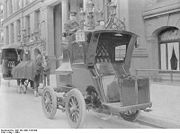
Gaston Planté
Gaston Planté was the French physicist who invented the lead-acid battery in 1859. The lead-acid battery eventually became the first rechargeable electric battery marketed for commercial use.Planté was born on April 22, 1834, in Orthez, France...
in France in 1865, as well as his fellow countryman Camille Faure in 1881, paved the way for electric cars to flourish in Europe. An electric-powered two-wheel cycle was put on display at the 1867 World Exposition
Exposition Universelle (1867)
The Exposition Universelle of 1867 was a World Exposition held in Paris, France, in 1867.-Conception:In 1864, Emperor Napoleon III decreed that an international exposition should be held in Paris in 1867. A commission was appointed with Prince Jerome Napoleon as president, under whose direction...
in Paris by the Austrian
Austrian Empire
The Austrian Empire was a modern era successor empire, which was centered on what is today's Austria and which officially lasted from 1804 to 1867. It was followed by the Empire of Austria-Hungary, whose proclamation was a diplomatic move that elevated Hungary's status within the Austrian Empire...
inventor Franz Kravogl. France and Great Britain were the first nations to support the widespread development of electric vehicles. The lack of natural fossil resources in Switzerland resulted in the tiny European nation's rapid electrification of its railway network to reduce its dependence on foreign energy. In November 1881, French inventor Gustave Trouvé
Gustave Trouvé
Gustave Trouvé was a French electrical engineer of the 19th century. His inventions include:* First outboard motorboat* First electric powered automobile* Gunpowder powered ornithopter in 1870...
demonstrated a working three-wheeled automobile at the International Exhibition of Electricity in Paris
International Exposition of Electricity, Paris
The first International Exposition of Electricity in Paris ran from August 15, 1881 through to November 15, 1881 at the Palais de l'Industrie on the Champs-Elysees. It served to display the advances in electrical technology since the small electrical display at the 1878 Universal Exposition...
. English inventor Thomas Parker, who was responsible for innovations such as electrifying the London Underground
London Underground
The London Underground is a rapid transit system serving a large part of Greater London and some parts of Buckinghamshire, Hertfordshire and Essex in England...
, overhead tramways in Liverpool and Birmingham, and the smokeless fuel coalite
Coalite
Coalite is a brand of low-temperature coke used as a smokeless fuel. The title refers to the residue left behind when coal is carbonised at 640 degrees Celsius. It was invented by Thomas Parker in 1904. In 1936 the Smoke Abatement Society awarded its inventor a posthumous gold medal.Coalite is...
, claimed to have perfected a working electric car as early as 1884.
Electric trains were also used to transport coal
Coal
Coal is a combustible black or brownish-black sedimentary rock usually occurring in rock strata in layers or veins called coal beds or coal seams. The harder forms, such as anthracite coal, can be regarded as metamorphic rock because of later exposure to elevated temperature and pressure...
out of mines
Mining
Mining is the extraction of valuable minerals or other geological materials from the earth, from an ore body, vein or seam. The term also includes the removal of soil. Materials recovered by mining include base metals, precious metals, iron, uranium, coal, diamonds, limestone, oil shale, rock...
, as their motors did not use up precious oxygen. Before the pre-eminence of internal combustion engines, electric automobiles also held many speed and distance records. Among the most notable of these records was the breaking of the 100 km/h (62.1 mph) speed barrier, by Camille Jenatzy
Camille Jenatzy
Camille Jenatzy was a Belgian race car driver. He is known for breaking the land speed record three times and being the first man to break the 100 km/h barrier....
on April 29, 1899 in his 'rocket-shaped' vehicle Jamais Contente, which reached a top speed of 105.88 km/h (65.8 mph). Also notable was Ferdinand Porsche's design and construction of an all-wheel drive electric car, powered by a motor in each hub, which also set several records in the hands of its owner E.W. Hart.
The rise of the electric vehicle in America
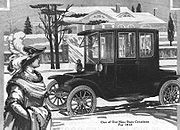
Iowa
Iowa is a state located in the Midwestern United States, an area often referred to as the "American Heartland". It derives its name from the Ioway people, one of the many American Indian tribes that occupied the state at the time of European exploration. Iowa was a part of the French colony of New...
; the vehicle was a six-passenger wagon capable of reaching a speed of 14 miles per hour (22.5 km/h). It was not until 1895 that Americans began to devote attention to electric vehicles, after A.L. Ryker introduced the first electric tricycles to the U.S., by that point, Europeans had been making use of electric tricycles, bicycles, and cars for almost 15 years. Many innovations followed, and interest in motor vehicles increased greatly in the late 1890s and early 1900s. In 1897, electric vehicles found their first commercial application as a fleet of electrical New York City taxis, built by the Electric Carriage and Wagon Company of Philadelphia, was established. Electric cars were produced in the U.S. by Anthony Electric, Baker
Baker Motor Vehicle
Baker Motor Vehicle Company was a manufacturer of Brass Era electric automobiles in Cleveland, Ohio from 1899 to 1914.-History:The first Baker vehicle was a two seater with a selling price of US$850. One was sold to Thomas Edison as his first car. Edison also designed the nickel-iron batteries used...
, Columbia
Columbia Automobile Company
The Columbia Automobile Company was a leading early Hartford, Connecticut, United States manufacturer of automobiles.The Columbia Automobile Company was created as a joint venture of the Motor Vehicle Division of the Pope Manufacturing Company of Hartford, Connecticut, and the Electric Vehicle...
, Anderson
Detroit Electric
Detroit Electric was an automobile brand produced by the Anderson Electric Car Company in Detroit, Michigan. Nowadays, a Chinese British entrepreneur is leading Detroit Electric to develop affordable and high quality pure electric vehicles in mainland Europe...
, Edison, Studebaker
Studebaker Electric (automobile)
The Studebaker Electric was an automobile produced by the Studebaker Brothers Manufacturing Company of South Bend, Indiana, a forerunner of the Studebaker Corporation. The battery-powered cars were sold from 1902 to 1912....
, Riker
Riker Electric Vehicle Company
The Riker was a veteran and brass era electric car founded in 1898 in Elizabeth, New Jersey.Designed by Andrew L. Riker, they were built in small numbers until the company was absorbed by the Electric Vehicle Company in 1901....
, and others during the early 20th century. In 1917, the first gasoline-electric hybrid car was released by the Woods Motor Vehicle Company of Chicago. The hybrid was a commercial failure, proving to be too slow for its price, and too difficult to service.

Transistor
A transistor is a semiconductor device used to amplify and switch electronic signals and power. It is composed of a semiconductor material with at least three terminals for connection to an external circuit. A voltage or current applied to one pair of the transistor's terminals changes the current...
-based electric technology, the top speed of these early electric vehicles was limited to about 32 km/h (19.9 mph). Despite their relatively slow speed, electric vehicles had a number of advantages over their early-1900s competitors. They did not have the vibration, smell, and noise associated with gasoline cars. Changing gears on gasoline cars was the most difficult part of driving, and electric vehicles did not require gear changes. While steam-powered cars also had no gear shifting, they suffered from long start-up times of up to 45 minutes on cold mornings. The steam cars had less range before needing water than an electric car's range on a single charge. Electric cars found popularity among well-heeled customers who used them as city cars, where their limited range proved to be even less of a disadvantage. The cars were also preferred because they did not require a manual effort to start, as did gasoline cars which featured a hand crank to start the engine. Electric cars were often marketed as suitable vehicles for women drivers due to this ease of operation; in fact, early electric cars were stigmatized by the perception that they were "women's cars", leading some companies to affix radiators to the front to disguise the car's propulsion system.
Acceptance of electric cars was initially hampered by a lack of power infrastructure, but by 1912, many homes were wired for electricity, enabling a surge in the popularity of the cars. At the turn of the century, 40 percent of American automobiles were powered by steam, 38 percent by electricity, and 22 percent by gasoline. 33,842 electric cars were registered in the United States, and America became the country where electric cars had gained the most acceptance. While basic electric cars cost under $1,000 (in 1900 dollars, roughly $ today), most early electric vehicles were massive, ornate carriages designed for the upper-class customers that made them popular. They featured luxurious interiors, replete with expensive materials, and averaged $3,000 by 1900 (roughly $ today). Sales of electric cars peaked in 1912.
In order to overcome the limited operating range of electric vehicles, and the lack of recharging infrastructure, a exchangeable battery service was first proposed as early as 1896. The concept was first put into practice by Hartford Electric Light Company through the GeVeCo battery service and initially available for electric trucks. The vehicle owner purchased the vehicle from General Vehicle Company (GVC, a subsidiary of the General Electric Company) without a battery and the electricity was purchase from Hartford Electric through an exchangeable battery. The owner paid a variable per-mile charge and a monthly service fee to cover maintenance and storage of the truck. Both vehicles and batteries were modified to facilitate a fast battery exchange. The service was provided between 1910 to 1924 and during that periord covered more than 6 million miles. Beginning in 1917 a similar successful service was operated in Chicago
Chicago
Chicago is the largest city in the US state of Illinois. With nearly 2.7 million residents, it is the most populous city in the Midwestern United States and the third most populous in the US, after New York City and Los Angeles...
for owners of Milburn Light Electric cars who also could buy the vehicle without the batteries.
1920s to 1980s: Gasoline dominates
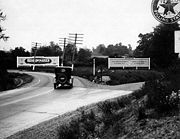
Auto trail
The system of auto trails was an informal network of marked routes that existed in the United States and Canada in the early part of the 20th century. Marked with colored bands on telephone poles, the trails were intended to help travellers in the early days of the automobile.Auto trails were...
was being created between American cities; in order to make use of these roads, vehicles with greater range than that offered by electric cars were needed. The discovery of large reserves of petroleum
Petroleum
Petroleum or crude oil is a naturally occurring, flammable liquid consisting of a complex mixture of hydrocarbons of various molecular weights and other liquid organic compounds, that are found in geologic formations beneath the Earth's surface. Petroleum is recovered mostly through oil drilling...
in Texas, Oklahoma, and California led to the wide availability of affordable gasoline
Gasoline
Gasoline , or petrol , is a toxic, translucent, petroleum-derived liquid that is primarily used as a fuel in internal combustion engines. It consists mostly of organic compounds obtained by the fractional distillation of petroleum, enhanced with a variety of additives. Some gasolines also contain...
, making gas-powered cars cheaper to operate over long distances. Electric cars were limited to urban use by their slow speed (no more than 24–32 km/h or 15–20 mph) and low range (30–40 miles or 50–65 km), and gasoline cars were now able to travel farther and faster than equivalent electrics. Gasoline cars became ever easier to operate thanks to the invention of the electric starter by Charles Kettering
Charles Kettering
Charles Franklin Kettering was an American inventor, engineer, businessman, and the holder of 186 patents. He was a founder of Delco, and was head of research for General Motors for 27 years from 1920 to 1947. Among his most widely used automotive inventions were the electrical starting motor and...
in 1912, which eliminated the need of a hand crank for starting a gasoline engine, and the noise emitted by ICE cars became more bearable thanks to the use of the muffler
Muffler
A muffler is a device for reducing the amount of noise emitted by the exhaust of an internal combustion engine. A US Patent for an Exhaust muffler for engines was granted to Milton and Marshall Reeves in 1897....
, which had been invented by Hiram Percy Maxim
Hiram Percy Maxim
Hiram Percy Maxim was an American radio pioneer and inventor, and co-founder of the American Radio Relay League . He originally had the amateur call signs SNY, 1WH, 1ZM, 1AW, and later W1AW, which is now the ARRL Headquarters club station call sign...
in 1897. Finally, the initiation of mass production
Assembly line
An assembly line is a manufacturing process in which parts are added to a product in a sequential manner using optimally planned logistics to create a finished product much faster than with handcrafting-type methods...
of gas-powered vehicles by Henry Ford
Henry Ford
Henry Ford was an American industrialist, the founder of the Ford Motor Company, and sponsor of the development of the assembly line technique of mass production. His introduction of the Model T automobile revolutionized transportation and American industry...
brought the price as low $440 in 1915 (equivalent to roughly $ today), and $360 by 1916 (roughly $ today). By contrast, the price of similar electric vehicles continued to rise; in 1912, an electric roadster sold for $1,750 (roughly $ in today), while a gasoline car sold for less than half of that, $650 (roughly $ today).
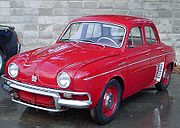
Forklift truck
A forklift is a powered industrial truck used to lift and transport materials. The modern forklift was developed in the 1920s by various companies including the transmission manufacturing company Clark and the hoist company Yale & Towne Manufacturing...
s were electrically powered when they were introduced by Yale in 1923. In Europe, especially the United Kingdom, milk float
Milk float
A milk float is a battery electric vehicle , specifically designed for the delivery of fresh milk. They were once common in many European countries, particularly the United Kingdom, and were operated by local dairies...
s were historically powered by electricity. Electric golf carts were produced by Lektro as early as 1954. By the 1920s, the heyday of electric cars had passed, and a decade later, the American electric automobile industry had effectively disappeared. A thorough examination into the social and technological reasons for the failure of electric cars was discussed by author Michael Brian in his book Taking Charge: The Electric Automobile in America.
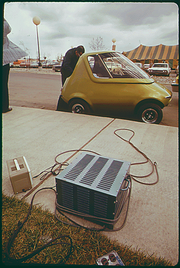
Internal combustion engine
The internal combustion engine is an engine in which the combustion of a fuel occurs with an oxidizer in a combustion chamber. In an internal combustion engine, the expansion of the high-temperature and high -pressure gases produced by combustion apply direct force to some component of the engine...
development progressed at a brisk pace, electric vehicle technology stagnated. In the late 1950s, Henney Coachworks and the National Union Electric Company, makers of Exide batteries, formed a joint venture to produce a new electric car, the Henney Kilowatt
Henney Kilowatt
The Henney Kilowatt was an electric car introduced in the United States for the 1959 model year.-Corporate funding:The Henney Kilowatt was a project of National Union Electric Company, a conglomerate including Emerson Radio, and Henney Motor Company, which had purchased Eureka Williams in 1953. The...
. The car was produced in 36-volt
Volt
The volt is the SI derived unit for electric potential, electric potential difference, and electromotive force. The volt is named in honor of the Italian physicist Alessandro Volta , who invented the voltaic pile, possibly the first chemical battery.- Definition :A single volt is defined as the...
and 72-volt configurations; the 72-volt models had a top speed approaching 96 km/h (59.7 mph) and could travel for nearly an hour on a single charge. Despite the Kilowatt's improved performance with respect to previous electric cars, consumers found it too expensive compared to equivalent gasoline cars of the time, and production ended in 1961.
In 1959, American Motors Corporation
American Motors
American Motors Corporation was an American automobile company formed by the 1954 merger of Nash-Kelvinator Corporation and Hudson Motor Car Company. At the time, it was the largest corporate merger in U.S. history.George W...
(AMC) and Sonotone Corporation announced a joint research effort to consider producing an electric car that was to be powered by a "self-charging" battery. AMC had a reputation for innovation in economical cars while Sonotone had technology for making sintered plate nickel-cadmium batteries
Nickel-cadmium battery
The nickel–cadmium battery ' is a type of rechargeable battery using nickel oxide hydroxide and metallic cadmium as electrodes....
that could be recharged rapidly and weighed less than traditional lead-acid versions. That same year, Nu-Way Industries showed an experimental electric car with a one-piece plastic body that was to begin production in early 1960.
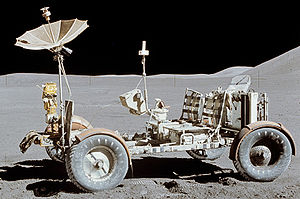
Lithium battery
Lithium batteries are disposable batteries that have lithium metal or lithium compounds as an anode. Depending on the design and chemical compounds used, lithium cells can produce voltages from 1.5 V to about 3.7 V, over twice the voltage of an ordinary zinc–carbon battery or alkaline battery...
and a speed controller designed by Victor Wouk. A nickel-cadmium battery supplied power to an all-electric 1969 Rambler American
Rambler American
The Rambler American is an automobile manufactured by the American Motors Corporation between 1958 and 1969. The American was the second incarnation of AMC's forerunner Nash Motors second-generation Rambler compact that was sold under the Nash and Hudson Motors marques from 1954 and 1955.The...
station wagon. Other "plug-in" experimental AMC vehicles developed with Gulton included the Amitron
Amitron
The Amitron was an American electric concept car built in 1967 by American Motors Corporation and Gulton Industries of Metuchen, New Jersey.- Design :...
(1967) and the similar Electron
Electron (vehicle)
The Electron was an American concept automobile built in 1977 by American Motors Corporation .- Design :The experimental three-passenger commuter "city car" was designed for short-trip urban transportation. The clamshell-style roof swung back on rear-mounted pivots for entry and egress.The Electron...
(1977). More battery-electric concept cars appeared over the years, such as the Scottish Aviation Scamp
Scottish Aviation Scamp
The Scottish Aviation Scamp is a small concept electric city car that was designed between 1964 and 1966 by Scottish Aviation.A prototype, known as "the farm cart" was built which showed promise, accelerating from a standstill to in ten seconds, giving a top speed of and a range of in urban...
(1965), the Enfield 8000
Enfield 8000
The Enfield 8000 was a 2-seater battery-electric city car, introduced in 1973 and originally built on the Isle of Wight in the United Kingdom by Enfield Automotive, under the ownership of Greek millionaire Giannis Goulandris. 120 cars were built in the UK, of which 65 were used by the Electricity...
(1966) and two electric versions of General Motors gasoline cars, the Electrovair
Chevrolet Corvair
-First generation :The 1960 Corvair 500 and 700 series four-door sedans were conceived as economy cars offering few amenities in order to keep the price competitive, with the 500 selling for under $2,000...
(1966) and Electrovette
Chevrolet Chevette
The Chevrolet Chevette was introduced in September, 1975 and manufactured for model years 1976-1987 based on GM's worldwide T platform and superseding the Vega as Chevrolet's entry-level subcompact...
(1976). None of them entered production.
On July 31, 1971, an electric car received the unique distinction of becoming the first manned vehicle to be driven on the Moon
Moon
The Moon is Earth's only known natural satellite,There are a number of near-Earth asteroids including 3753 Cruithne that are co-orbital with Earth: their orbits bring them close to Earth for periods of time but then alter in the long term . These are quasi-satellites and not true moons. For more...
; that car was the Lunar rover
Lunar rover
The Lunar Roving Vehicle or lunar rover was a battery-powered four-wheeled rover used on the Moon in the last three missions of the American Apollo program during 1971 and 1972...
, which was first deployed during the Apollo 15
Apollo 15
Apollo 15 was the ninth manned mission in the American Apollo space program, the fourth to land on the Moon and the eighth successful manned mission. It was the first of what were termed "J missions", long duration stays on the Moon with a greater focus on science than had been possible on previous...
mission. The "moon buggy" was developed by Boeing
Boeing
The Boeing Company is an American multinational aerospace and defense corporation, founded in 1916 by William E. Boeing in Seattle, Washington. Boeing has expanded over the years, merging with McDonnell Douglas in 1997. Boeing Corporate headquarters has been in Chicago, Illinois since 2001...
and Delco Electronics
Delco Electronics
Delco Electronics Corporation was the automotive electronics design and manufacturing subsidiary of General Motors based in Kokomo, Indiana.The name Delco came from the Dayton Engineering Laboratories Co., founded in Dayton, Ohio by Charles Kettering and Edward A...
, and featured a DC drive motor in each wheel, and a pair of 36-volt silver-zinc potassium hydroxide non-rechargeable batteries.
1990s to present: Revival of mass interest
After years outside the limelight, the energy crises of the 1970s and 80s brought about renewed interest in the perceived independence electric cars had from the fluctuations of the hydrocarbon energy market. At the 1990 Los Angeles Auto Show, General MotorsGeneral Motors
General Motors Company , commonly known as GM, formerly incorporated as General Motors Corporation, is an American multinational automotive corporation headquartered in Detroit, Michigan and the world's second-largest automaker in 2010...
President Roger Smith unveiled the GM Impact concept electric car, along with the announcement that GM would build electric cars for sale to the public.
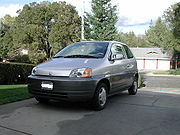
California Air Resources Board
The California Air Resources Board, also known as CARB or ARB, is the "clean air agency" in the government of California. Established in 1967 in the Mulford-Carrell Act, combining the Bureau of Air Sanitation and the Motor Vehicle Pollution Control Board, CARB is a department within the...
(CARB), the government of California
California
California is a state located on the West Coast of the United States. It is by far the most populous U.S. state, and the third-largest by land area...
's "clean air agency", began a push for more fuel-efficient, lower-emissions vehicles, with the ultimate goal being a move to zero-emissions vehicle
Zero-emissions vehicle
A zero-emissions vehicle, or ZEV, is a vehicle that emits no tailpipe pollutants from the onboard source of power. Harmful pollutants to the health and the environment include particulates , hydrocarbons, carbon monoxide, ozone, lead, and various oxides of nitrogen. Although not considered emission...
s such as electric vehicles. In response, automakers developed electric models, including the Chrysler TEVan
Chrysler TEVan
The Chrysler TEVan was a battery electric vehicle produced from 1993 to 1995 by Chrysler and sold primarily to electric utilities throughout the United States. The first generation used either nickel-iron or nickel-cadmium batteries. Only 56 were produced and were sold for approximately $120,000 each...
, Ford Ranger EV
Ford Ranger EV
The Ford Ranger EV is a battery electric vehicle produced by Ford Motor Company. It was produced starting in the 1998 model year through 2002 and is no longer in production. It is built upon a light truck chassis used in the Ford Ranger. A few vehicles with lead-acid batteries were sold, but most...
pickup truck, GM EV1 and S10 EV
Chevrolet S10 EV
The Chevrolet S-10 Electric was introduced in 1997 by General Motors, updated in 1998, and then discontinued. It was an OEM BEV variant of Chevrolet's S-10 pickup truck which ran solely upon electricity, and was marketed primarily to utility fleet customers....
pickup, Honda EV Plus
Honda EV Plus
The Honda EV Plus was the first battery electric vehicle from a major automaker with non-lead acid batteries. Roughly 340 EV Plus models were produced and released. The EV Plus was taken out of production in 1999 when Honda announced the release of its first hybrid electric vehicle, the Honda Insight...
hatchback, Nissan lithium-battery Altra EV miniwagon and Toyota RAV4 EV
Toyota RAV4 EV
The RAV4 EV was an all-electric version of the popular RAV4 SUV produced by Toyota. It was leased from 1997 to 2003, and at the lessees request, many units were sold after the vehicle was discontinued. A total of 1,485 were leased and/or sold in California to meet the state’s mandate for...
.
The automakers were accused of pandering to the wishes of CARB in order to continue to be allowed to sell cars in the lucrative Californian market, while failing to adequately promote their electric vehicles in order to create the impression that the consumers were not interested in the cars, all the while joining oil industry lobbyists in vigorously protesting CARB's mandate. GM's program came under particular scrutiny; in an unusual move, consumers were not allowed to purchase EV1s, but were instead asked to sign closed-end leases, meaning that the cars had to be returned to GM at the end of the lease period, with no option to purchase, despite lessor interest in continuing to own the cars. Chrysler, Toyota, and a group of GM dealers sued CARB in Federal court, leading to the eventual neutering of CARB's ZEV
Zero-emissions vehicle
A zero-emissions vehicle, or ZEV, is a vehicle that emits no tailpipe pollutants from the onboard source of power. Harmful pollutants to the health and the environment include particulates , hydrocarbons, carbon monoxide, ozone, lead, and various oxides of nitrogen. Although not considered emission...
Mandate.
After public protests by EV drivers' groups upset by the repossession of their cars, Toyota offered the last 328 RAV4-EVs for sale to the general public during six months, up until November 22, 2002. Almost all other production electric cars were withdrawn from the market and were in some cases seen to have been destroyed
Car crusher
A car crusher is an industrial device used to reduce the dimensions of derelict cars prior to transport for recycling.Car crushers are compactors and can be of two types: "pancake", where a scrap automobile is flattened by a huge descending hydraulically-powered plate, or the baling press type,...
by their manufacturers. Toyota continues to support the several hundred Toyota RAV4-EV in the hands of the general public and in fleet usage. GM famously de-activated the few EV1s that were donated to engineering schools and museums.
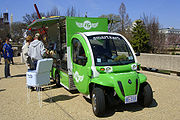
Bangalore
Bengaluru , formerly called Bengaluru is the capital of the Indian state of Karnataka. Bangalore is nicknamed the Garden City and was once called a pensioner's paradise. Located on the Deccan Plateau in the south-eastern part of Karnataka, Bangalore is India's third most populous city and...
, India, as a joint venture between the Maini Group India and AEV of California. After seven years of research and development, it launched the REVAi, known as the G-Wiz i in the United Kingdom, in 2001. California company Tesla Motors
Tesla Motors
Tesla Motors, Inc. is a Silicon Valley-based company that designs, manufactures and sells electric cars and electric vehicle powertrain components. It was the only automaker building and selling a zero-emission sports car, the Tesla Roadster, in serial production...
, hoping to gain a foothold in the electric sports car market, released the Lotus Elise
Lotus Elise
The 1996 Lotus Elise weighed . Because of its relatively low weight, it was able to accelerate 0- in 5.8 seconds despite its relatively low power output of...
-based Tesla Roadster
Tesla Roadster
The Tesla Roadster is a battery electric vehicle sports car produced by the electric car firm Tesla Motors in California. The Roadster was the first highway-capable all-electric vehicle in serial production available in the United States. Since 2008 Tesla has sold 2,024 Roadsters in 30 countries...
in 2008. Aptera Motors plan to release their futuristic 2e
Aptera 2 Series
The Aptera 2 Series is an upcoming high-efficiency passenger three-wheeled automobile produced by Aptera Motors. The California-based company opened a pre-ordering process for residents of California, but stopped taking deposits in July 2011, and on August 12, 2011, Aptera announced it will return...
in 2011.
Throughout the 1990s, interest in fuel-efficient or environmentally friendly cars declined among Americans, who instead favored sport utility vehicles, which were affordable to operate despite their poor fuel efficiency thanks to lower gasoline prices. American automakers chose to focus their product lines around the truck-based vehicles, which enjoyed larger profit margins than the smaller cars which were preferred in places like Europe or Japan. In 1999, the Honda Insight
Honda Insight
The Honda Insight is a hybrid electric vehicle manufactured by Honda and the first production vehicle to feature Honda's Integrated Motor Assist system. The first-generation Insight was produced from 1999 to 2006 as a three-door hatchback...
hybrid car became the first hybrid to be sold in North America since the little-known Woods hybrid of 1917.
Hybrids, which featured a combined gasoline and electric powertrain, were seen as a balance, offering an environmentally friendly image and improved fuel economy, without being hindered by the low range of electric vehicles, albeit at an increased price over comparable gasoline cars. Sales were poor, the lack of interest attributed to the car's small size and the lack of necessity for a fuel-efficient car at the time. The 2000s energy crisis brought renewed interest in hybrid and electric cars. In America, sales of the Toyota Prius
Toyota Prius
The Toyota Prius is a full hybrid electric mid-size hatchback, formerly a compact sedan developed and manufactured by the Toyota Motor Corporation...
(which had been on sale since 1999 in some markets) jumped, and a variety of automakers followed suit, releasing hybrid models of their own. Several began to produce new electric car prototypes, as consumers called for cars that would free them from the fluctuations of oil prices.
The global economic recession in the late 2000s led to increased calls for automakers to abandon fuel-inefficient SUVs, which were seen as a symbol of the excess that caused the recession, in favor of small cars, hybrid cars, and electric cars. The most immediate result of this was the announcement of the 2010 release of the Chevrolet Volt
Chevrolet Volt
The Chevrolet Volt is a plug-in hybrid electric vehicle manufactured by General Motors. The Volt has been on sale in the U.S. market since mid-December 2010, and is the most fuel-efficient compact car sold in the United States, as rated by the United States Environmental Protection Agency...
, a plug-in hybrid car that represents the evolution of technologies pioneered by the EV1 of the 90s. The Volt will be able to travel for up to 40 miles (64.4 km) on battery power alone before activating an ICE to run a generator which re-charges its batteries.
As of July 2006, there are between 60,000 and 76,000 low-speed, battery powered vehicles in use in the United States, up from about 56,000 in 2004. BYD
BYD
BYD could refer to:* BYD Company , a rechargeable battery producer in the People's Republic of China** BYD Automobile, subsidiary company of BYD Company and an automobile manufacturer in China...
of China has created an electric MPV
Minivan
Minivan is a type of van designed for personal use. Minivans are typically either two-box or one box designs for maximum interior volume – and are taller than a sedan, hatchback, or a station wagon....
with a 250 miles (402.3 km) range, the E6
BYD e6
BYD e6 is an all-electric crossover car manufactured by BYD Auto with a range of according to the carmaker. Field testing began in China in May 2010 with 40 units operating as taxis in the city of Shenzhen...
, which it expects to sell in China beginning in late 2009, and in North America in 2011. In 2009, Mitsubishi Motors and PSA Peugeot Citroën
PSA Peugeot Citroën
PSA Peugeot Citroën is a French manufacturer of automobiles and motorcycles sold under the Peugeot and Citroën marques. Headquartered in the 16th arrondissement of Paris, PSA is the second largest automaker based in Europe and the number eight in the world.-History:In December 1974 Peugeot S.A....
announced a joint venture to produce electric vehicle technology. A number of electric vehicles are currently being developed by manufacturers large and small, including the all-electric sedan from CODA Automotive
Coda Automotive
CODA Automotive Inc. is a privately held American company headquartered in Los Angeles, California, that designs, semi manufactures, and sells electric vehicles and Lithium-ion battery systems built for automotive and power storage utility applications...
, a Southern California-based company.
At the 1990 Los Angeles Auto Show, General Motors
General Motors
General Motors Company , commonly known as GM, formerly incorporated as General Motors Corporation, is an American multinational automotive corporation headquartered in Detroit, Michigan and the world's second-largest automaker in 2010...
President Roger Smith unveiled the GM Impact electric concept car
Concept car
A concept vehicle or show vehicle is a car made to showcase new styling and or new technology. They are often shown at motor shows to gauge customer reaction to new and radical designs which may or may not have a chance of being produced....
, along with the announcement that GM would build electric cars for sale to the public.
In the early 1990s, the California Air Resources Board
California Air Resources Board
The California Air Resources Board, also known as CARB or ARB, is the "clean air agency" in the government of California. Established in 1967 in the Mulford-Carrell Act, combining the Bureau of Air Sanitation and the Motor Vehicle Pollution Control Board, CARB is a department within the...
(CARB), the government of California
California
California is a state located on the West Coast of the United States. It is by far the most populous U.S. state, and the third-largest by land area...
's "clean air agency", began a push for more fuel-efficient, lower-emissions vehicles, with the ultimate goal being a move to zero-emissions vehicle
Zero-emissions vehicle
A zero-emissions vehicle, or ZEV, is a vehicle that emits no tailpipe pollutants from the onboard source of power. Harmful pollutants to the health and the environment include particulates , hydrocarbons, carbon monoxide, ozone, lead, and various oxides of nitrogen. Although not considered emission...
s such as electric vehicles.
In 2000, Hybrid Technologies, later renamed Li-ion Motors
Li-ion Motors
Li-ion Motors Corp., winners of the Progressive Automotive X-Prize, is a company based in Las Vegas, Nevada engaged in developing and marketing electrics cars, motorbikes and other vehicles and products based on lithium-ion battery technology...
, started manufacturing electric cars in Mooresville, North Carolina
Mooresville, North Carolina
Mooresville is a large suburban town in southern Iredell County, North Carolina, USA. It is in the Metrolina metro area. The population was 32,133 at the 2010 United States Census...
. There has been increasing controversy with Li-ion Motors
Li-ion Motors
Li-ion Motors Corp., winners of the Progressive Automotive X-Prize, is a company based in Las Vegas, Nevada engaged in developing and marketing electrics cars, motorbikes and other vehicles and products based on lithium-ion battery technology...
though due to the ongoing 'Lemon issues' regarding their product. and their attempt to cover it up. California
California
California is a state located on the West Coast of the United States. It is by far the most populous U.S. state, and the third-largest by land area...
electric car maker Tesla Motors
Tesla Motors
Tesla Motors, Inc. is a Silicon Valley-based company that designs, manufactures and sells electric cars and electric vehicle powertrain components. It was the only automaker building and selling a zero-emission sports car, the Tesla Roadster, in serial production...
began development in 2004 on the Tesla Roadster
Tesla Roadster
The Tesla Roadster is a battery electric vehicle sports car produced by the electric car firm Tesla Motors in California. The Roadster was the first highway-capable all-electric vehicle in serial production available in the United States. Since 2008 Tesla has sold 2,024 Roadsters in 30 countries...
, which was first delivered to customers in 2008. The Roadster remained the only highway-capable EV in serial production and available for sale until 2010. Senior leaders at several large automaker
Automaker
The automotive industry designs, develops, manufactures, markets, and sells motor vehicles, and is one of the world's most important economic sectors by revenue....
s, including Nissan and General Motors
General Motors
General Motors Company , commonly known as GM, formerly incorporated as General Motors Corporation, is an American multinational automotive corporation headquartered in Detroit, Michigan and the world's second-largest automaker in 2010...
, have stated that the Roadster was a catalyst which demonstrated that there is pent-up consumer demand for more efficient vehicles. GM Vice Chairman Bob Lutz said in 2007 that the Tesla Roadster inspired him to push GM to develop the Chevrolet Volt
Chevrolet Volt
The Chevrolet Volt is a plug-in hybrid electric vehicle manufactured by General Motors. The Volt has been on sale in the U.S. market since mid-December 2010, and is the most fuel-efficient compact car sold in the United States, as rated by the United States Environmental Protection Agency...
, a plug-in hybrid sedan prototype that aims to reverse years of dwindling market share and massive financial losses for America's largest automaker. In an August 2009 edition of The New Yorker, Lutz was quoted as saying, "All the geniuses here at General Motors kept saying lithium-ion technology is 10 years away, and Toyota agreed with us -- and boom, along comes Tesla. So I said, 'How come some tiny little California startup, run by guys who know nothing about the car business, can do this, and we can't?' That was the crowbar that helped break up the log jam."
The Nissan LEAF
Nissan Leaf
Nissan introduced its first battery electric vehicle, the Nissan Altra at the Los Angeles International Auto Show on 29 December 1997. The Altra EV was produced between 1998 and 2002, only about 200 vehicles were ever produced, and it was mainly used as a fleet vehicle for companies such as...
introduced in Japan and the United States in 2010 is the first all electric, zero emission five door family hatchback to be produced for the mass market from a major manufacturer. Lithium-ion battery technology, smooth body shell and advanced regenerative braking give the LEAF performance comparable to an ICE, a range of around 160 km and the capability to reach 80% recharge levels in under 30 minutes. In June 2009 BMW
BMW
Bayerische Motoren Werke AG is a German automobile, motorcycle and engine manufacturing company founded in 1916. It also owns and produces the Mini marque, and is the parent company of Rolls-Royce Motor Cars. BMW produces motorcycles under BMW Motorrad and Husqvarna brands...
began field testing in the U.S. of its all-electric Mini E
Mini E
The Mini E is a demonstration electric car developed by BMW as a conversion of its Mini Cooper car. The MINI E was developed for field trials and deployed in several countries, including the United States, Germany, UK, France, Japan and China...
, through the leasing of 500 cars to private users in Los Angeles and the New York
New York
New York is a state in the Northeastern region of the United States. It is the nation's third most populous state. New York is bordered by New Jersey and Pennsylvania to the south, and by Connecticut, Massachusetts and Vermont to the east...
/New Jersey
New Jersey
New Jersey is a state in the Northeastern and Middle Atlantic regions of the United States. , its population was 8,791,894. It is bordered on the north and east by the state of New York, on the southeast and south by the Atlantic Ocean, on the west by Pennsylvania and on the southwest by Delaware...
area. A similar field test was launched in the U.K. in December 2009 with a fleet of more than forty Mini E cars. General Electric plans to buy 25,000 electric vehicles and convert more than half its fleet to electricity by 2015.
Select historical production vehicles
Selected list of battery electric vehicles include (in chronological order):| Name | Production years | Number produced | Top Speed | Cost | Range | mpg US L/100 km (City) |
mpg US L/100 km (Hwy) |
|---|---|---|---|---|---|---|---|
| Baker Electric Baker Motor Vehicle Baker Motor Vehicle Company was a manufacturer of Brass Era electric automobiles in Cleveland, Ohio from 1899 to 1914.-History:The first Baker vehicle was a two seater with a selling price of US$850. One was sold to Thomas Edison as his first car. Edison also designed the nickel-iron batteries used... |
1899–1915 | ? | 14 mph 23 km/h |
US$2300 or €1,700 | 50 mi 80 km |
||
| Detroit Electric Detroit Electric Detroit Electric was an automobile brand produced by the Anderson Electric Car Company in Detroit, Michigan. Nowadays, a Chinese British entrepreneur is leading Detroit Electric to develop affordable and high quality pure electric vehicles in mainland Europe... |
1907–1939 | <5000 | 20 mph 32 km/h |
>US$3,000 or €2,250 depending on options | 80 mi (130 km) | ||
| Henney Kilowatt Henney Kilowatt The Henney Kilowatt was an electric car introduced in the United States for the 1959 model year.-Corporate funding:The Henney Kilowatt was a project of National Union Electric Company, a conglomerate including Emerson Radio, and Henney Motor Company, which had purchased Eureka Williams in 1953. The... |
1958–1960 | <100 | 60 mph 97 km/h |
? | ? | ||
| Škoda Favorit Škoda Favorit The Škoda Favorit 135 and Škoda Favorit 136 were a range of small family cars produced by Czech auto manufacturer Škoda Auto from 1987 to 1995. It was Škoda Auto's first car to follow the European trend of locating the engine at the front, mounted transversely, and was also their first car to use... ELTRA 151L & 151 Pick-Up |
1992–1994 | <1100, perhaps 20 surviving | 50 mph 80 km/h (limiter) |
< US $20,000, without subsidy | 50 mi 80 km |
||
| General Motors EV1 General Motors EV1 The General Motors EV1 was an electric car produced and leased by the General Motors Corporation from 1996 to 1999. It was the first mass-produced and purpose-designed electric vehicle of the modern era from a major automaker, and the first GM car designed to be an electric vehicle from the... |
1996–2003 | 1117 | 80 mph 129 km/h |
~ US$40,000 or €30,000, without subsidies Subsidy A subsidy is an assistance paid to a business or economic sector. Most subsidies are made by the government to producers or distributors in an industry to prevent the decline of that industry or an increase in the prices of its products or simply to encourage it to hire more labor A subsidy (also... |
160 mi 257 km |
||
| Chevrolet S10 EV Chevrolet S10 EV The Chevrolet S-10 Electric was introduced in 1997 by General Motors, updated in 1998, and then discontinued. It was an OEM BEV variant of Chevrolet's S-10 pickup truck which ran solely upon electricity, and was marketed primarily to utility fleet customers.... |
1997–1998 | 492 | 73 mph 118 km/h |
~ US$40,000 or €30,000, without subsidies Subsidy A subsidy is an assistance paid to a business or economic sector. Most subsidies are made by the government to producers or distributors in an industry to prevent the decline of that industry or an increase in the prices of its products or simply to encourage it to hire more labor A subsidy (also... |
90 mi 144 km |
||
| Honda EV Plus Honda EV Plus The Honda EV Plus was the first battery electric vehicle from a major automaker with non-lead acid batteries. Roughly 340 EV Plus models were produced and released. The EV Plus was taken out of production in 1999 when Honda announced the release of its first hybrid electric vehicle, the Honda Insight... |
1997–1999 | ~300 | 80+ mph 130+ km/h |
US$455 or €340/month for 36 month lease Lease A lease is a contractual arrangement calling for the lessee to pay the lessor for use of an asset. A rental agreement is a lease in which the asset is tangible property... ; or $53,000 or €40,000 without subsidies |
80–110 mi 130–180 km |
||
| Toyota RAV4 EV Toyota RAV4 EV The RAV4 EV was an all-electric version of the popular RAV4 SUV produced by Toyota. It was leased from 1997 to 2003, and at the lessees request, many units were sold after the vehicle was discontinued. A total of 1,485 were leased and/or sold in California to meet the state’s mandate for... |
1997–2002 | 1249 | 78 mph 125 km/h |
US$40,000 or €30,000 without subsidies | 87 mi 140 km |
125 1.88 |
100 2.35 |
| Ford Ranger EV Ford Ranger EV The Ford Ranger EV is a battery electric vehicle produced by Ford Motor Company. It was produced starting in the 1998 model year through 2002 and is no longer in production. It is built upon a light truck chassis used in the Ford Ranger. A few vehicles with lead-acid batteries were sold, but most... |
1998–2002 | 1500, perhaps 200 surviving | ~ US$50,000 or €37,600; subsidized down to $20,000 or €15,000 | 74 mi 119 km |
|||
| THNK City Think Nordic Think Global is an electric car company located in Oslo, Norway, which manufactures cars under the TH!NK brand. Production of the Th!nk City was stopped in March 2011 and the company filed for bankruptcy on June 22, 2011, for the fourth time in 20 years; but the company was bought soon after by... |
1999–2002 | 1005 | 56 mph 90 km/h |
53 mi 85 km |
106 1.59 |
83 2.83 |
|
| REVA REVA The REVAi, known as G-Wiz in the UK, is a small micro electric car, made by the Indian manufacturer REVA Electric Car Company since 2001... |
2001– | 2500 | 45 mph 72 km/h |
£8,000, US$15,000 or €11,900 | 50 mi 80 km |
||
| ZAP Xebra | 2006–2009 | 700+ | 40 mph 65 km/h |
$10,000 or €7,500 | 25 mi 40 km |
||
| Tesla Roadster Tesla Roadster The Tesla Roadster is a battery electric vehicle sports car produced by the electric car firm Tesla Motors in California. The Roadster was the first highway-capable all-electric vehicle in serial production available in the United States. Since 2008 Tesla has sold 2,024 Roadsters in 30 countries... |
2008– | 1500+ | 130 mph 210 km/h http://www.teslamotors.com/performance/specs.php |
US$109,000 or €99,000 base price http://www.teslamotors.com/performance/specs.php | 220 mi 350 km |
less than 2 cents/mile off peak recharge |
See also
- History of the automobileHistory of the automobileThe history of the automobile begins as early as 1769, with the creation of steam engined automobiles capable of human transport. In 1806, the first cars powered by an internal combustion engine running on fuel gas appeared, which led to the introduction in 1885 of the ubiquitous modern gasoline-...
- History of plug-in hybridsHistory of plug-in hybridsThe history of plug-in hybrid electric vehicles spans a little more than a century, but most of the significant commercial developments have taken place after 2002.-1899-1999:...
- History of electric motorcycles and scootersHistory of electric motorcycles and scooters* Late 1860s: Earliest references to electric motorcycles can be found in patents.* 1911: Electric motorcycle available according to early Popular Mechanics article....
External links
- Alternative Fuel Vehicles Timeline
- An Extensive Electric Vehicle History
- Hybrid-Vehicle.org: Early Electric Cars
- Analysis by Richard H. Schallenberg for the IEEE Transactions on Education
- 1997 Dissertation by David A. Kirsch, Stanford University
- "1955 Business Analysis of Early Electric Vehicles", John B. Rae, Associate Professor of History, MIT
- History And Directory Of Electric Cars From 1834 to 1987
- Short Electric, And Other Vehicle History
- Mikes Railway History, 1935: Electric Traction
- some Electric information as well
- SVE Website
- Electric Car Society
- EV World -US Internet Journal about EVs

